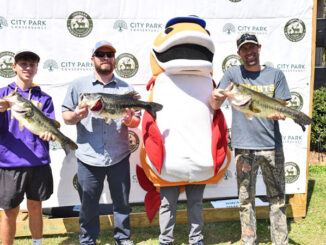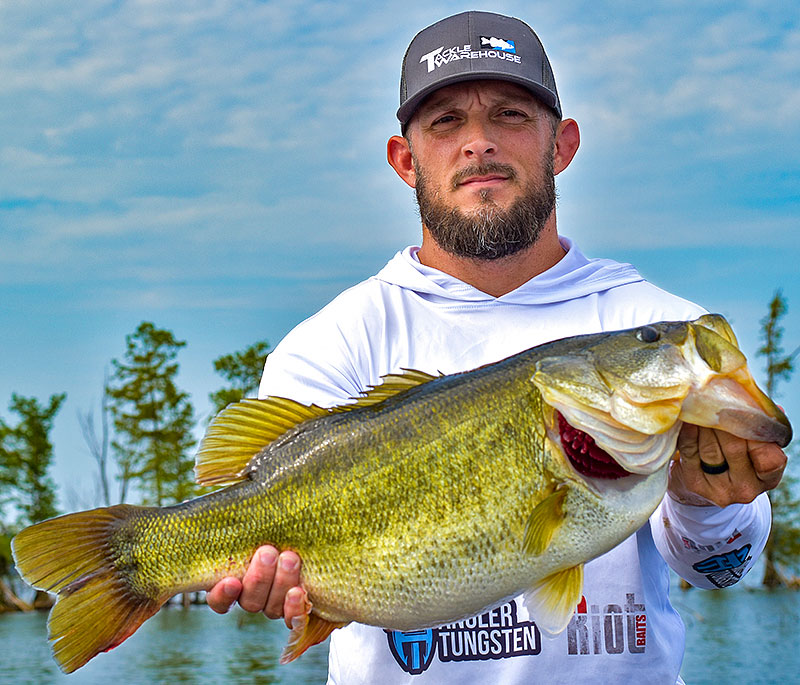
Nothing screams “success” like a 10-pound bass on your boat’s deck
In baseball, it’s the walk-off home run. In golf, it’s the hole in one. In the New Year’s fireworks show, it’s the grand finale that lights up the sky so you can see from a high spot in the neighboring parish.
In fishing, it is all about landing the Double D. The walk-off catch for novice and professional bass fishermen alike.
Double D as in a 10-pounder or better. It’s the piscatorial pinnacle for just about any angler who consistently tosses lures for largemouths.
For many years back in the day as bass fishing became a premier sport in America, Louisiana anglers had to read about those Double D’s in magazines and newspapers from Texas or Florida, with the exception of one every once in a while, of course.
But today, things have changed. There are a variety of opinions as far as to why. Some say it’s the use of forward facing sonar that allows anglers a real-life looking view of the lake below them, and the fish hanging out there as well. Some say it is the re-emergence of aquatic grasses in our best trophy lakes that boost the entire food chain and produce bigger bass. Others say the Florida bass stocking program and catch-and-release practices play an important role. Truth be known, it’s probably a little bit of all of that plus more.
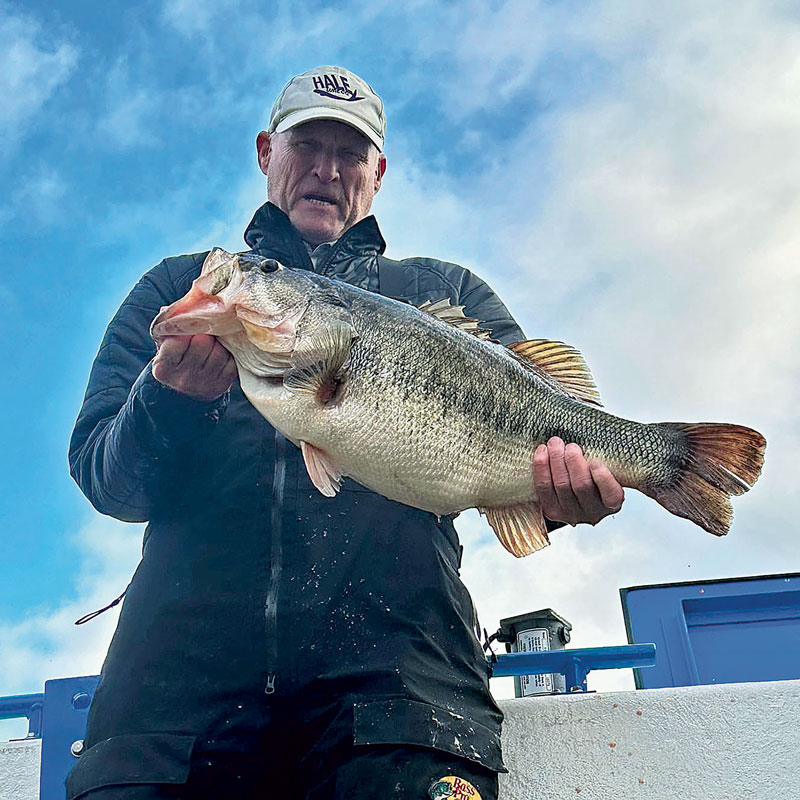
Hard to decipher
The facts are hard to decipher, but most lean toward it being the sonar. It is also probably angler knowledge and skill at figuring out how to make big bass hit a plethora of new baits that fish just can’t resist, either because they are hungry or they just get tired of seeing it thrown in their face 10 or 20 times.
If it’s the Florida bass program, it took its sweet time. Check out these paragraphs from Louisiana Sportsman back in 2017 talking about when the Louisiana Department of Wildlife and Fisheries first began the program 41 years ago.
“In the never-ending quest to produce more bigger fish for anglers to catch, the Louisiana Department of Wildlife and Fisheries has been stocking Florida largemouth bass in the state since 1982.
Florida largemouth bass (FLMB) have been deemed genetically different enough from all the other largemouth bass in the country, lumped together as northern largemouth bass (NLMB), to be considered a separate subspecies.
To the average eye, there are very little physical differences between FLMB and NLMB, primarily slightly smaller scales on the FLMB. But an important difference for fishermen does exist. FLMB grow much larger than NLMB.”
At one time, your best bet to catch a DD in Louisiana was at Toledo Bend, or a small private lake stocked exclusively with Florida strain and managed like a health club for bass.
Toledo Bend is still a top target. Consider the explosion of the number of DD’s entered into the Toledo Bend Lunker Bass Program during the May 2022 to May 2023 season. The program certified 57 10-pound-plus bass in that period, including a new lake record. In the same time frame for 2021-2022, only 32 DD bass were caught, weighed and released back in the lake.
But before we celebrate last year too much, consider the first year the program took place in 2015-2016. There were 139 bass brought in through the program during a peak growth period on the lake. Toledo Bend had the gates closed and began filling in 1966. The lake covers 185,000 acres and is 65 miles long.
But when it comes to the BODD’s (Biggest of Double Digits) Toledo Bend had been bumped from the top 10 list for years. That was until Bill Cook of Houston landed a 15.67-pound largemouth in February 2023, breaking the 22-year-old Toledo Bend record held by a 15.32-pound fish caught by Eric Weems. That new lake record is the fourth largest ever caught and recorded in Louisiana waters.
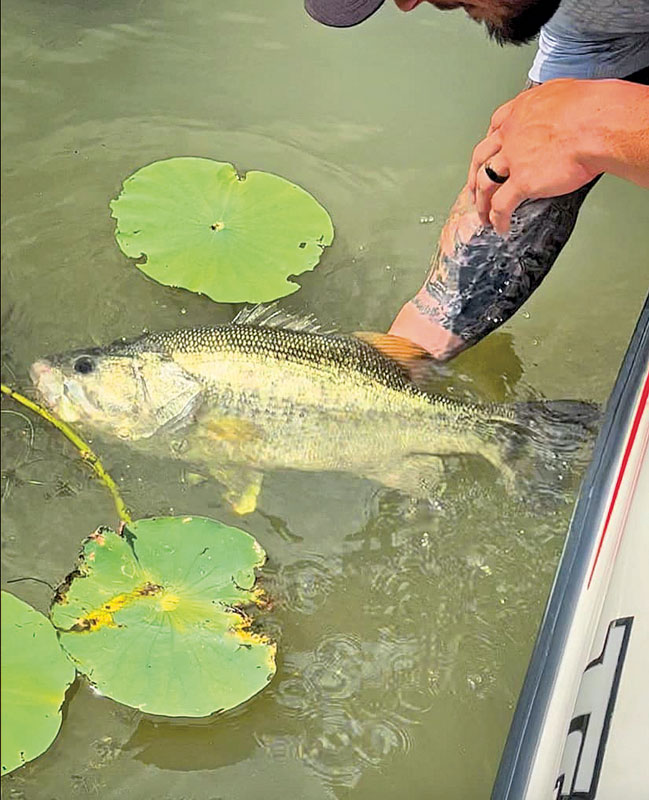
What’s it like?
What is the thrill like to catch a Double D? For veteran anglers, it’s probably even greater than a novice because the vets know what they’ve got when they land one. One of those who broke into the club in 2023 was Blake DeCorte from Monroe.
“I had been trying to catch a bass that broke the 10-pound mark ever since they reopened Bussey Brake,” DeCorte said. “Well, even
before that on other lakes, but seriously on Bussey. Then it happened, on an unlikely day in the middle of July.
“With the spawn behind us, I knew the odds of huge bass were down because of the lack of eggs that early season bass have. But we had been fishing hard and when I set the hook into this bass, it didn’t move. When you set the hook and it doesn’t move, it’s either a huge bass or a log, but this was like a slowly floating log. Then it took off. I knew she was big and when she came up, I saw the belly and thought it was maybe a nine pounder.
“I said to get the net and I didn’t realize exactly how big it was until we laid it on the front deck. I just looked on in silence and thought ‘Oh my gosh, I can’t believe we caught this thing.’”
The bass weighed 11 pounds, 4 ounces, but by the measurements, the taxidermist said it would have weighed 2-3 pounds more full of eggs. DeCorte said he caught the big one just by plain old fashioned fishing methods. The fish was at the base of a big bush. He found it by simply tossing his Riot creature bait in hundreds of bushes before hitting the right one. Bussey, he said, is so thick with cover, that electronics don’t really play a part.
Just for the record, Robert Rush of Crossett, Arkansas, caught a new Bussey Brake lake record in February of 2023, a 15.36 pounder.
Like Bussey, the state’s other top lunker largemouth factory is smaller, but a hotspot for 10-pounders as well. Caney Lake near Chatham produces 10-pound-plus bass like Joe Burrow produces touchdown passes. Caney covers just about 5,000 acres and Bussey just over 2,000.
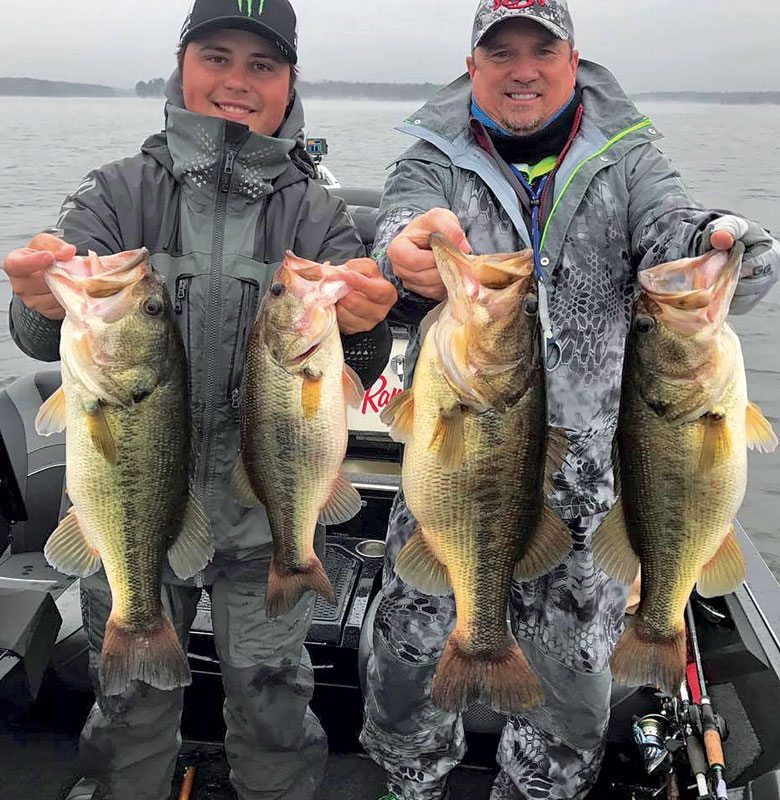
National attention
Those three lakes received national attention when they were pegged by the renowned Bassmaster magazine as the top three lakes in Louisiana for 2023 for that very reason.
In recognizing these waterbodies as the Daddy’s of the Double D, that group of experts pointed out that the Caney Lake ranking is largely due to some great tournament weights and single numbers of 10-pound-plus bass caught in the past few years. Habitat conditions are currently driving the surge in big fish. Toledo Bend Reservoir just keeps producing “hawgs” and increasing amounts of grass should continue that trend. Also, average winning weights for tournaments are boosted by the addition of 10-pound kickers in many events.
It’s no surprise that Bussey Brake broke into the list for the first time this year after producing an astonishing number of lunkers since it was restored and re-opened to the public in 2020. Most of this production is due to the large number of pure Florida strain brood fish that were provided by LDWF’s own Booker Fowler fish hatchery and excellent habitat that is just like a new, fertile lake. In fact, those that fish it regularly will bet you money the next state record will come from this Morehouse Parish lake, maybe even this year.
So why are they your best bet for landing a Double D in 2024? If that information above isn’t enough, consider this.
They have a combination of all those factors we mentioned earlier. Fishermen are more talented using forward facing sonar, the lakes have growing amounts of grass to kick-start the food chain and they have big numbers of Florida strain bass.
There’s one thing almost everybody is in agreement on. Anglers who catch a Double D should make every effort to handle it with care and release it back into the water as soon as possible. By taking measurements, you can get an almost exact duplicate mount made if you desire. Those huge fish are not good to eat and putting them back serves a double purpose. It keeps their gene pool active in the lake and it may give somebody else, possibly a youngster, the chance to catch the fish again.
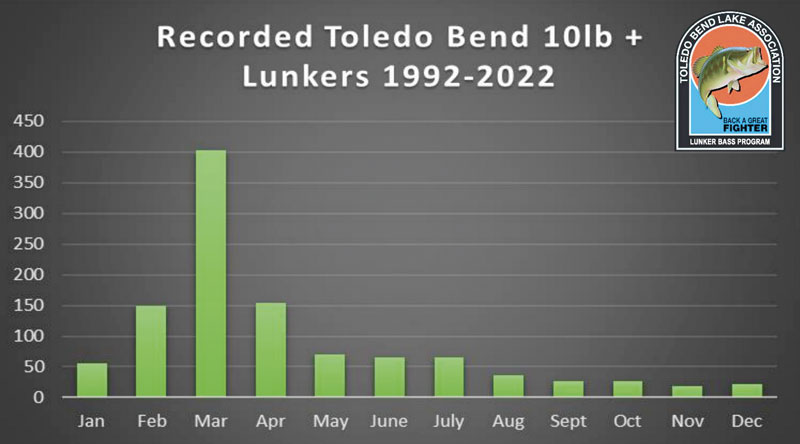
More to it
There is another factor involved with the large number of 10-pounders being caught at Toledo Bend, according to Gary Moore, President of the highly successful Toledo Bend Lake Association that sponsors and runs the highly successful Toledo Bend Lunker Bass Program.
“It’s not just the number of 10-pounders we saw last year that is impressive,” Moore said. “It’s the number of ‘super fish,’ the ones that are 12 pounds and over, anchored by that new lake record. The electronics and the grass and other factors play a part, but the fact that the majority of these fish were caught in February during the pre-spawn is significant.
“These fish were not caught spawning. They were caught in the pre-spawn and I think that is directly related to the fact that anglers are learning to catch these big fish suspended over brush piles in deeper water. That’s the key. More and more anglers are able to locate the structure in these pre-spawn areas and catch these fish. They can also see their bait relative to the structure and even if they can’t see the big fish all the time, they can see that they are getting a lure in there where they are.”
Moore said that not all the big fish are spotted on electronics, but anglers use them to find the piles of structure that hold them. And you can see if there are fish down there on that structure most of the time.
Moore said he thinks more 10-pounders and “super fish” have been there all along over the years and this new trend of catching them deeper and earlier — before the spawn — will continue to see more Lunker Program fish brought to the scales.
Other options
You don’t have to be on one of these three famous lakes to catch a double digit lunker.
When you cast a line today, you never know where you will catch a 10-pounder. The Louisiana State Fish Records, maintained by the Louisiana Outdoor Writers Association (LOWA), also show entries from Valentine Lake near Alexandria, Black Bayou – Hosston Lake near Shreveport, University Lake in Baton Rouge and Lake D’Arbonne in Farmerville. There are also several private lakes and ponds that produce 10-pounders fairly regularly.
In fact, two documented 10 pounders were caught on Lake D’Arbonne in 2023, one in the summer and one in the fall, but neither made it to the official scales. One was weighed by the angler in his boat, photographed and released back right on the spot because he didn’t want to take a chance on the fish dying in the still-hot water.
The second was caught by a tournament angler in practice and while he was trying to hold the fish over the side of the boat to take a photo after weighing it, he dropped his phone in the lake instead. Thinking about the fish as well, he just let it go right in the same spot as the phone.
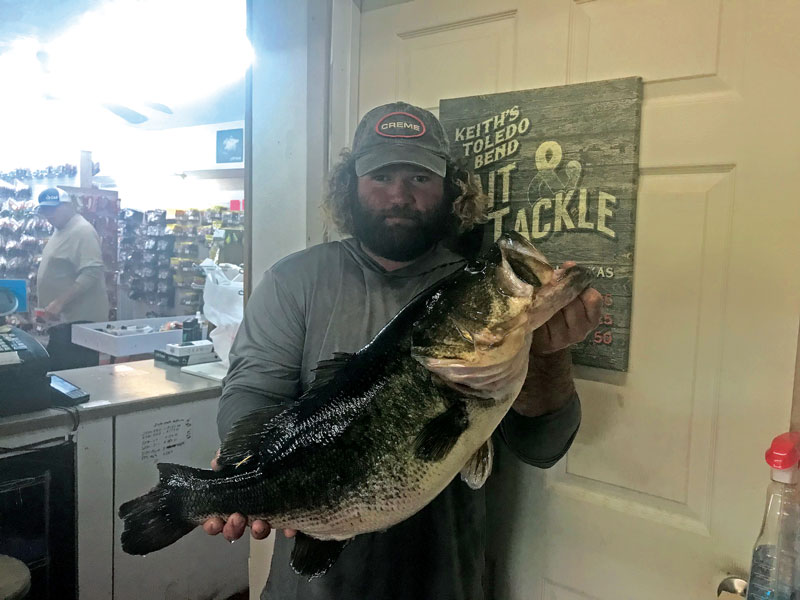
Luck or skill?
Most folks would say, “Man, you are lucky” if they saw someone catch a 10-pound bass. But it takes a lot of skill, too. One definition of luck is preparation meeting opportunity, and that’s the way one pro angler and member of the Double D Club puts it.
“It takes some of both,” said Brett Preuett, who guides part-time on Toledo Bend when he isn’t fishing the pro circuits. “You definitely have to have some luck just to look at a 10-pounder and then it sure doesn’t hurt to have some when getting the fish out of the brush and into the boat. But it is skill that puts you in the right place at the right time, making the right presentation to get that big bite. A lot of anglers probably toss their bait right by a big bass, but they don’t do what it takes to make the fish bite.”
Preuett caught his third Double D this past fall on Toledo Bend, a 10.84-pound bass.
Preuett also addressed the electronics issue, saying there are two sides of that story. First of all, you can locate the structure and sometimes the big fish on electronics, but mostly they are just a guide to get you in the right spots. Sometimes you can see large fish on the units, but it doesn’t mean you can catch them. Quite a few of the bigger fish caught were without electronics other than general location.
“Electronics help, there’s no doubt,” he said. “I mean, you can see on the forward facing sonar whether a fish is big or not, but you can’t ride around and look for one that you can tell is necessarily a 10-pounder.
“The one I caught at Toledo Bend late last year was hugging so close to the bottom that the sonar didn’t even pick her up. I had seen several small dots on the spot I was fishing. I just happened to cast it right to the big one and she bit.”
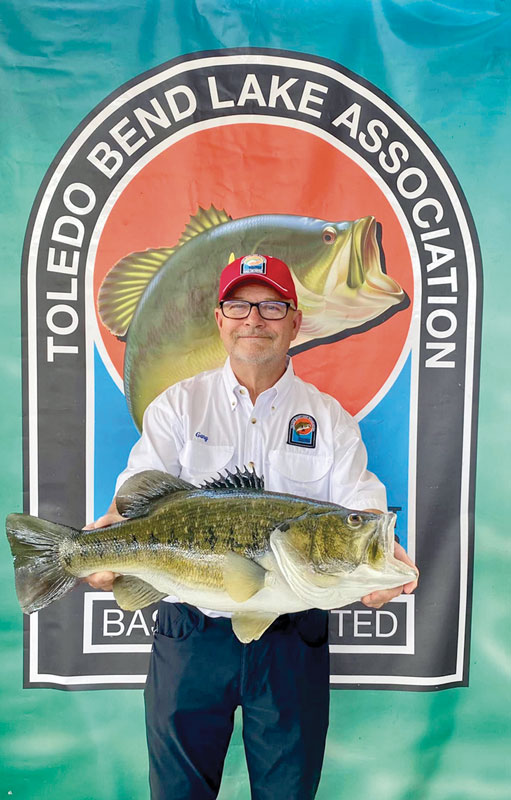
The Toledo Bend Lunker Bass Program
Toledo Bend anglers are fortunate in that they can have their cake and eat it, too… so to speak.
They can weigh their big fish, have it turned loose back into the lake to fight another day and then have their fish “mounted,” thanks to the Toledo Bend Lake Association (TBLA).
The Toledo Bend Lunker Bass Program was initiated by the Sabine River Authority of Louisiana in 1992 and continued by Toledo Town & Tackle in 1998. Sponsorship was transferred to the TBLA in 2005. From 1992 through last season, more than 1,200 lunkers have been caught and released through the program.
The goal of the program is to encourage the return of trophy fish to the lake by rewarding anglers a replica bass for releasing their Toledo Bend lunkers. TBLA hopes each bass will spawn and produce more potential lunkers and also continue to grow and be caught again by another angler. To qualify for a lunker bass replica, the fish must be weighed, registered, and released alive by TBLA or its representative.
TBLA provides an angler a free fiberglass replica for any bass weighing 10 pounds or more, provided rules are met.
And the best part for fishermen? It’s free.
Thanks to a lot of hard work and fundraisers like the TBLA’s annual Bass Unlimited Banquet and annual raffle, the association’s membership raises 100 percent of the money to pay for replicas and management of the program.

You caught it, now make sure it’s official!
Most people are shocked when they catch a 10-pound-plus lunker bass, and really shocked if they catch a super fish like a 12 or 13-pounder. So just in case, be prepared.
If you are fishing Toledo Bend, Caney or Bussey, you can put your big fish in the livewell and take it to have it officially weighed with a relatively small amount of trouble, then have it released back to make more baby lunker bass and maybe get caught by another lucky angler one day.
Get your catch verified by a LDWF biologist if you can, and take pictures and measurements of the fish and the scales. If you don’t have a good cell phone camera, somebody nearby will and they’ll be glad to help. Get a credible witness that it is indeed a largemouth bass, if you can.
Official weigh spots for Toledo Bend on the Louisiana side are Buckeye Landing on the south lake (318-586-4757 or 318-508-2971) and Living the Dream on the mid-lake (318-256-8991 or 318-228-5870). On the Texas side, sites include Fin & Feather Resort (409-579-2056); Fairmount General Store (409-579-9080); Keith’s Toledo Bend Tackle (409-625-0181); Holly Park (409-625-4424 or 936-596-5343), and Huxley Bay Marina (866-733-8193).
On Caney Lake, there are two marinas that have certified scales. Laine’s Landing (318-259-6649), formerly Browns landing, is located on the north end of the lake just above the bridge. Hooks Marina (318-249-2347), is on the Spillway side of Caney Lake on the south end.
At Bussey, there is no full-time marina, but the LDWF maintains a certified scale at the Main Boat Dock. There is a phone number posted there for you to call. They will give you a code to unlock the scales and when you are finished you can lock them back up.


